From getting started to optimizing and testing, these expert tips will ensure your ecommerce PPC ads are set up to stand out.
Here, you’ll find:
- How to create a proper ecommerce PPC marketing foundation
- Ways to optimize, organize, and test your PPC campaigns
- How to grow your success beyond Google Shopping ad campaigns
- SEM tricks to create successful ads that convert
Ecommerce holiday spending was up yet again in 2022, reaching $211.70 billion in online sales in November and December.
But surprisingly, just 17% of brands said they’re ahead of the curve or leading in the ecommerce space in their industry.
That tells us there’s a wealth of opportunity for your ecommerce company to rise above the ranks. One of the most effective ways to do just that: paid search (also called pay-per-click or PPC) campaigns.
Whether you’ve been doing ecommerce for years or have recently switched to a digital platform amid the pandemic, it’s always good to know what elements make up a successful Google search engine marketing (SEM) ad.
Traditional search campaigns are powered by keywords. But with ecommerce PPC ads, it’s all about the product feed.
Wondering how to get started with ecommerce PPC campaigns? You’ve come to the right place. Let’s break down what steps to take when creating paid search ads for your ecommerce brand.
How you get your products into GMC to create the feed mostly depends on how many products you have. (Image: Rawpixel)
1. Set up your Google Merchant Center account properly
It should come as no surprise that the right setup is key to creating successful ecommerce PPC ads. But plenty of companies, whether or not they realize it, don’t have their accounts set up properly.
This can lead to improper tracking and unnecessary steps. So, how do you ensure you’re starting your ecommerce PPC management on the right foot?
Link your account via a shared email address
To begin, you need to create a free Google Merchant Center (GMC) account. It’s best to use the same email you use for programs like Google Ads (formerly Google Adwords) and Google Analytics. That way, your accounts will all be linked.
From there, you can link your Google Ads account to GMC. It’s also a good idea to install ecommerce tracking in your Google Analytics account for even more insight into performance metrics.
Choose a product data input method
Next, it’s time to get your products into the Google Merchant Center. A few things to consider when determining how to get your product data into GMC are:
- Which ecommerce platform will you be leveraging?
- How many products will you be uploading?
- How many product variations with individual SKUs will you be uploading?
- Do you have all the product details organized?
How you get your products into GMC to create the feed mostly depends on how many products you have. If you have a lot of products and are using a popular ecommerce marketing platform, such as Shopify or BigCommerce, it should be easy to integrate with GMC.
This will help map your product feed and submit the most updated info to GMC regularly, ensuring your product data is always fresh.
If you’ve got a smaller number of products, you can simply integrate manually via a Google spreadsheet. You can also manually add products one by one if you want to test out the platform first.
Pro tip: If your product list is especially large, Google’s file processor Centimani might be a great solution for you.
Optimize your Merchant Center settings
There are a lot of GMC settings that often get overlooked. One is enabling automatic updates.
Google will crawl your page and find your most updated price and availability if you opt in to get automatic improvements.
This is great if, for example, you run out of stock on a product, because it keeps you from running Google Ads to a page where your products aren’t available. However, if you have your site structured in a way that keeps Google from understanding your pricing, it’s probably best to turn off the automatic price updates.
Once you have everything in GMC, you’ll connect to your Google Ads account and manage your ecommerce PPC efforts there. Way back in April 2020, Google announced that they’d run free listings on Google Shopping. This Shopping section is a lot like Amazon in that you can filter by things like price.
This means it’s more important than ever to get your GMC created with your products and prices because you’ll start getting an organic lift from being on the Shopping tab for free. This can be especially helpful for local SEO.
Pro tip: Even if your ecommerce business doesn’t have the budget for new campaigns, we still recommend going into GMC and setting up a feed, because you’ll be eligible for free listings in the U.S.
2. Stay on top of your product feed
Once you set up your GMC account, don’t fall into a set-it-and-forget-it mindset.
Making sure to update your product feed is just as crucial as proper setup. (The last thing you want is to have someone click on your ad and see that the item is out of stock or priced higher than advertised, right?)
Once you input products, they’ll remain active for 30 days. After that, those products will expire if you don’t update their info, meaning they won’t be eligible to show potential customers.
You can update your products either by reprocessing your feed or setting up automatic processing on a daily or weekly basis, depending on how often your product inventory changes.
It’s also important to keep your prices updated. A 2021 GMC update increased the scrutiny on prices. Prices listed in your product data, on your landing pages, and at checkout must match. They’ll give you 28 days to resolve the mismatch before suspending your account.
Including prices in your ads can be a highly effective way to get more clicks than your competition. (Image: Rawpixel)
3. Set up your ecommerce PPC ads campaign
It’s pretty easy to get started once you have GMC linked. It’s usually a good idea to start with a standard Shopping campaign.
Smart Shopping is usually best fueled by having a solid foundation of account data. If you’re just getting started, you may want to run a manual cost-per-click (CPC) campaign first, then experiment with Smart Shopping or automated bidding down the road.
We helped furniture, decor, and design services brand Grayson Living grow e-commerce sales by 279% in the first year alone. Check out this case study to see how we did it.
Get granular
The #1 way to set yourself up for campaign success is to get granular. That’s because the more specific a product search is, the higher the purchase intent is likely to be.
The more you segment your products, the more targeted your PPC ads will be. It makes sense: someone searching for a specific brand, style, color, and size of running shoe is probably more motivated to buy than someone just searching with the term “running shoe.”
You can split products into separate campaigns and ad groups that can then be split further into product groups. If you have a small, manageable number of products, you can break everything out by single-product product groups.
An example: Let’s say your core products are sporting goods, but you also sell apparel as 20% of your business. It may be wise to put all of your apparel into a separate campaign to make sure you’re giving most of your budget to your core products.
You can also divide in other ways, like by devices. Take, for example, a 100% bid adjustment to separate desktop and mobile. For your desktop campaign, you’d put in a 100% bid adjustment on mobile to show only on desktop, and vice versa.
You can separate traffic based on how specific the search is by setting up campaign priorities and then using negative keywords to segregate those searches. Google’s 2021 GMC updates include additional sizing attributes which may be helpful as well.
But that’s not the only way to get granular with your PPC campaigns. Jordan Fultz, a SEM Manager at HawkSEM, recommends being as specific as possible with shipping and return policies.
“You can set shipping expectations for the holiday rush, or you can set expectations by day of the week in normal sale times,” he explains. “GMC has features to help with the specifics of the holiday rush, too.” For example, you can place something like “Free delivery by Sat, Dec. 24” directly into your ad.
He also advises investigating whether certain products in specific states don’t collect sales tax. This is an opportunity to reduce your prices as low as possible. For instance, in New York and Connecticut, clothing and footwear priced under $110 are tax-free).
Pro tip: Google Shopping is unique because it has a priority system — you can set low, medium, and high priority campaigns. If you have several Shopping campaigns, this system dictates which ones serve an ad first.
Include prices in your ads
Your GMC account isn’t the only place you want to make sure your prices are visible. Including prices in your ads can be a highly effective way to get more clicks than your competition. Not only can this help qualify your traffic to ensure you get the right clicks, but it doesn’t take up a ton of valuable ad real estate.
As HubSpot explains, “This saves your ad spend for those qualified leads who saw your prices, know what to expect, might not be scared away by price, and are much more likely to convert into a sale.”
Even if they don’t end up buying your product or service, you’ll have a higher chance of snagging them through remarketing, since they already know what your pricing looks like.
Google recently added a “Deals” feed to the SERP (search engine results pages). When you’re running a promotion, sale, or have products with a recent price drop, consumers searching for deal- or sales-related listings will see your products.
Pro tip: To help products stand out, use promotions and set up the feed to enable strikethrough pricing in Shopping ads. This is when original prices are crossed out to indicate temporarily lowered prices (creating FOMO).
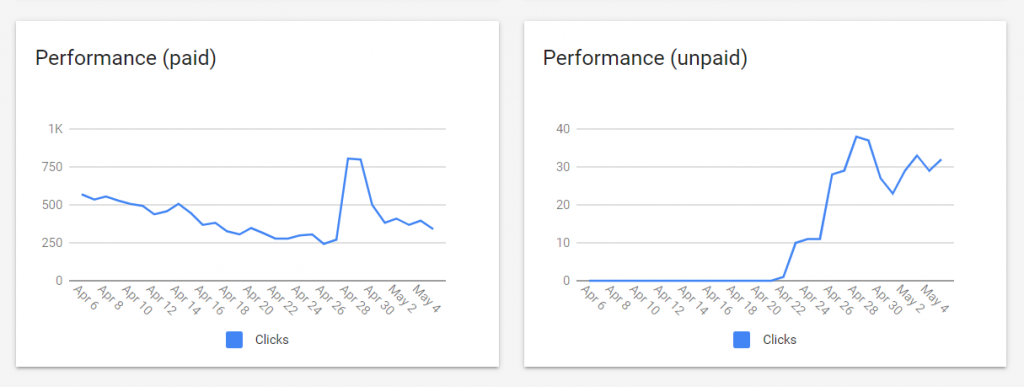
A look at how GMC has recently started reporting free clicks (via Google Merchant Center)
Remember to optimize
Without optimizing, your PPC campaign can only go so far. Optimizing will help you better manage your budget by putting more spend where you’re seeing more success.
There are two major KPIs to consider when optimizing a Shopping campaign. If you’re on a manual bidding strategy, pay attention to conversion volume and the result of conversion value over cost. That will calculate a rough idea of your return on ad spend (ROAS).
Many ecommerce companies optimize their bids by starting low, then adjusting accordingly. The more data you gather, the more informed your decisions will be.
After you’ve accrued some data, you can decrease bids on anything under your goal or average. You can also increase bids on items that are producing the most conversion value when compared to ad spend.
With Shopping, you can’t run a traditional experiment within Google Ads, but you can switch over for a time period and compare after a while. Automatic bidding strategies are powered by data, so the longer you run them, the better they should get.
If you’re going to try Smart Shopping, it’s a good idea to pick a mix of high and low performers, then exclude those from your regular Shopping campaign. Don’t simply pick all your low performers from your regular Shopping campaign and put them in Smart Shopping. You want a mix to ensure you’re getting accurate results.
Other ways to optimize include:
- Experiment with different ad types (like product listing ads vs. text ads)
- Leverage ad extensions to give ads more context
- Add pricing to ads for a competitive edge
- Test different campaign structures and categories
Pro tip: We don’t recommend running the same products in your traditional and Smart Shopping campaigns. If you do, Smart Shopping will automatically take precedence.
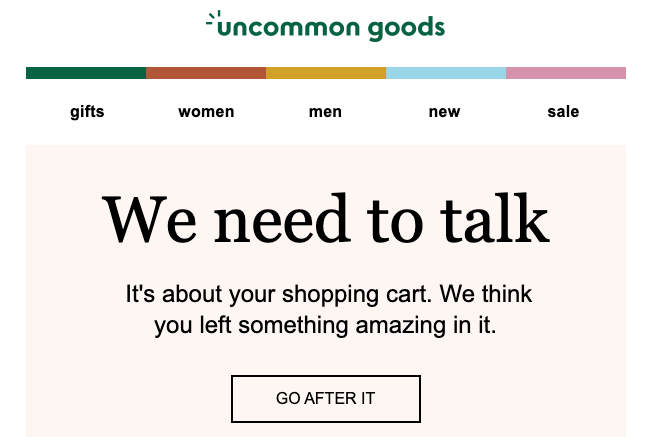
A remarketing email from Uncommon Goods triggered by cart abandonment.
If you’re planning a holiday sale, then use Google Ads’ seasonality tool to optimize ad performance.
“If you expect conversion rates (CVR) to increase by 20% for a few days, such as during a Black Friday sale, signal to Google that the CVR will be higher,” Fultz says. “This way, the algorithmic smart bidding doesn’t take 1+ days to adjust. This prevents you from getting a slow start to holiday sales when most shoppers are active.”
Leverage dynamic remarketing
Ah, yes, remarketing — otherwise known as “those ads that follow you around the internet,” as your friends or family may describe them. But the fact remains that remarketing works, particularly for cart abandoners.
If you’re running Google Ads, you’re already paying for people to get to your ecommerce website. But, as consumers ourselves, we know not everyone buys the first time they visit a site or product page. That’s where dynamic remarketing comes in.
While remarketing (also called retargeting) can be effective in various industries, it’s particularly useful for ecommerce PPC ads. It can help you land more recurring sales, increase your campaign’s clickthrough rate (CTR), boost your ROI, and more.
Dynamic remarketing is a great way to nurture your funnel. At its core, this method aims to show users specific products they’ve viewed on your site. If they look at running shoes, you then show them that exact pair of shoes as a Shopping ad while they browse other sites on the web.
To set up dynamic remarketing, you generally have to add a bit of code to your site. This is powered by your GMC feed, so you have to make sure your account is set up and working if you want it to be successful.
A lot of people put things in their carts while shopping online, then don’t end up following through with the purchase. You can remarket these products to cart abandoners and, if you have the ecommerce settings set up correctly in Google Analytics, you should already have some audiences available.

Google will allow your products to remain active for 30 days without new product info. (Image: Unsplash)
4. Test your ads consistently
If you want high-performing ecommerce PPC ads, testing repeatedly is an important step.
You can A/B test elements like your imagery, verbiage, call to action (CTA), and more. After all, what works on your paid social media campaign might be a flop when it comes to SEM. See how a flat-lay image of an item on a white background performs against an image of a real-life scenario.
You may think you know what your target audience wants, but the results could end up surprising you.
5. Think beyond Google
It makes sense that, when you think of paid search ecommerce PPC ads, you automatically think of Google. And while it’s holding strong in its place as the top global search engine, it’s not the only one worth looking into. If you’re seeing success in Google and topping your impression share, why stop there?
You can easily carry your Shopping campaigns over to Bing, now rebranded to Microsoft Advertising. Along with the Bing search engine, this suite includes Yahoo!, MSN, and AOL.
Bing has a user base that searches 7.2 billion times a month. Depending on your ecommerce product, you could see less competition on Bing than on Google, and a potentially cheaper cost per click (CPC).
If you already have a Microsoft Ads account, it’s easy to get a merchant center account set up right from the ad platform. Microsoft will process this data just like Google. Once it reviews the product data, you can create a Shopping campaign within Microsoft or import a Shopping campaign from Google that’s already working well.
In Microsoft Ads, you can even import on a recurring basis. If you set up a recurring sync, you can optimize in one place and make sure it’s carried over easily, instead of having to manually optimize within each platform. You can even optimize based on the different platform behaviors if that proves advantageous.
Publish Amazon PPC ads
Think Amazon Advertising isn’t related to PPC? Think again. Amazon operates as a search engine and even has an advertising platform. It has various ad types and structures similar to what you find in traditional paid search campaigns.
So if you have an online store on Amazon marketplace and want to drive more user clicks and sales, then setting up an Amazon PPC ad campaign is your best bet. This is particularly helpful if you’re new and need to compete for new customers. Amazon PPC is one of the quickest methods for building brand awareness.
Similar to Google, you’ll find Amazon sponsored product listings at the top of its search page:
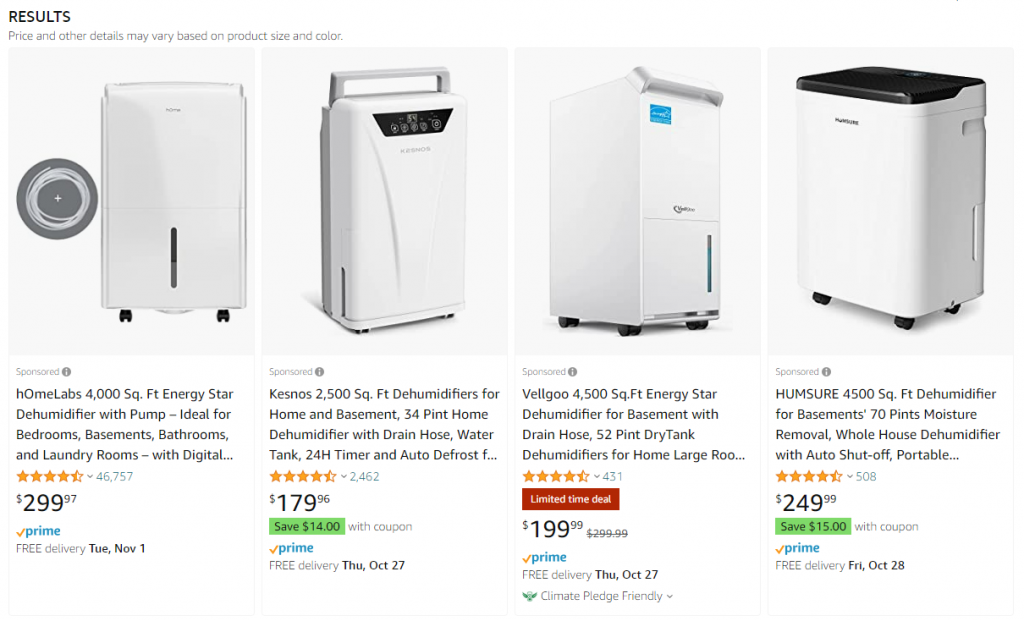
Sponsored product listings in Amazon search give your online store a competitive edge.
If you look at the two on the right, you find they only have hundreds of reviews and ratings, compared to those on the right that have thousands or even tens of thousands. Trying to get to the first page of Amazon without PPC ads with only hundreds of reviews is tough when competing against established brands.
Amazon’s ecommerce advertising platform allows you to do everything Google Ads does, including setting the demographics and search terms to target. The only difference is Amazon is where people go to shop, which increases the odds of growing conversions.
Like with any other campaign, you need to ensure your ad copy, images, and pricing is attractive to get clicks.
6. Use AI data analytics to enhance PPC campaign results
Lots of clicks = good. Low conversion rates = bad.
Using basic reasoning to determine the quality of your PPC ad campaigns will only take you so far. And only after wasting tons of money and time will you realize what truly works and doesn’t.
But what if there was a faster (and more efficient) way to identify the best search queries to bid on for maximum results? It’s possible when you AI data analytics to your advertising strategy.
For example, ConversionIQ, HawkSEM’s proprietary marketing technology, offers actionable insights to improve results. It does this by pinpointing high-converting audiences and the search terms they use, so you can reduce time spent on keyword research.
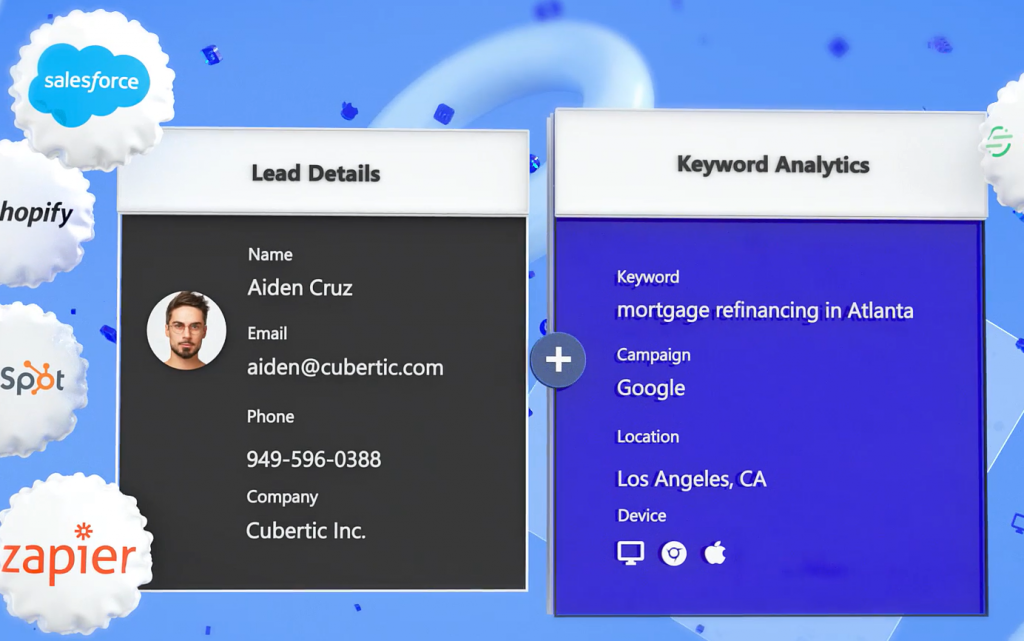
AI can identify your best prospects and keywords, so you can optimize campaigns for higher conversions.
Knowing exactly which keywords convert best makes ad management easier. And it focuses your marketing budget, so you’re getting the highest return per dollar spent.
7. Create AR ad experiences
The best ecommerce PPC marketing doesn’t just attract customers — it also entertains them. And if you can do it in a helpful way, then products will practically sell themselves. This is one reason augmented reality (AR) is a game changer for online retailers.
Allowing customers to try on makeup and accessories or see a piece of furniture in their living room before buying improves the user experience.
By adding AR to your ecommerce PPC strategy, you can stand apart from competitors and give shoppers a glimpse of your product.
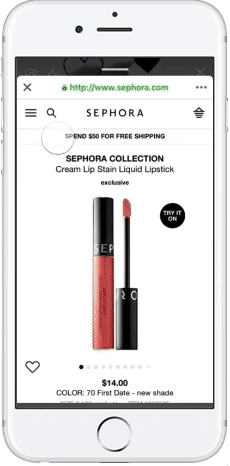
(Image: Instapage)
If you’re looking for a way to make your PPC advertising better, then consider augmenting the realities of prospective buyers.
The takeaway
Big brand. Little shop. Your size doesn’t matter on the web. If you can outperform established brands in ecommerce PPC ads, then you’re just as worthy of a thousand clicks. But to do this, you must learn the best PPC strategies and how to make your ads stand out.
Make sure your GMC account is set up properly, product info is fresh, experiments are consistent, and campaigns leverage all the avenues (Google, Microsoft, Amazon) at your disposal.
From there, you can build a strong digital marketing strategy that garners more clicks and sales, so your company continues to grow.
This article has been updated and was originally published in June 2020.